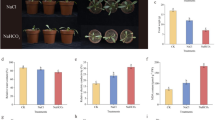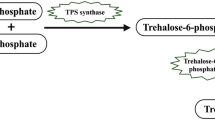Abstract
After 10 h osmotic stress in 25% polyethylene glycol (PEG6000) solution (−1.8 MPa) at 25 °C in darkness, the etiolated mungbean seedlings were transferred to pure water for recovery. The ethylene release rate and the level of reactive oxygen species (ROS), including superoxide radical (O2−) and hydrogen peroxide (H2O2), were investigated during the recovery process. The results showed that ethylene production rate and amount of ROS increased dramatically after osmotic stress, and a close correlation was observed between ethylene release rate and concentrations of ROS. Inhibitors of ethylene biosynthesis, aminoethoxyvinylglycine (AVG) or aminooxyacetic acid (AOA), could reduce the ethylene release rate, but had no significant influence to the content of O2− and H2O2. As well as, silver thiosulfate (STS), an inhibitor of ethylene action, exhibited no obvious effect to the concentration of ROS, showing stress-inducible ethylene was not the cause for the increase of stress-inducible ROS. On the other hand, exogenous generator of superoxide radical (methylviologen, MV, or sodium dithionite, Na2S2O4) could enhance the ethylene production evidently, which could be inhibited by exogenous scavenger of superoxide radical (superoxide dismutase, SOD, or 1, 4-diazabicyclo (2,2,2) octane, DABCO). However, either exogenous H2O2 or catalase (CAT) had no significant influence on ethylene production. The results suggested that it was superoxide radical but not H2O2which was involved directly in osmotic stress-inducible ethylene biosynthesis. The dual-role of superoxide radical on stress ethylene biosynthesis was also discussed.
Similar content being viewed by others
References
M. Banga E.J. Slaa C.W.P.M. Blom L.A.C.J. Voesenek (1996) ArticleTitleEthylene biosynthesis and accumulation under drained and submerged conditions Plant Physiol. 112 229–237
R.A. Greenwald (1987) Handbook of Methods for Oxygen Radical Research. CRC press Boca Raton, Florida 55–70
V.P. Grichko B.R. Glick (2001) ArticleTitleEthylene and flooding stress in plants Plant Physiol. Biochem. 39 1–9
H. Hagar N. Ueda S.V. Shah (1996) ArticleTitleRole of reactive oxygen metabolites in DNA damage and cell death in chemical hupoxic injury to LLC-PK1 cells Am. J. Physiol. 271 209–215
M.L. Jones W.R. Woodson (1999) ArticleTitleDifferential expression of three members of the 1-aminocyclopropane-1-carboxylate synthase gene family in carnation Plant Physiol. 119 755–764
D.S. Ke A.G. Wang G.C. Sun (2002) ArticleTitleThe effect of active oxygen on the activity of ACC synthase induced by exogenous IAA Acta Botanica Sinica 44 IssueID5 551–556
D.S. Ke A.G. Wang G.C. Sun (2003) ArticleTitleThe role of active oxygen in chilling-induced ethylene production in etiolated mungbean seedlings Acta Phytophysiol. Sinica 29 IssueID2 127–132
I. Llop-Tous C.S. Barry D. Grierson (2000) ArticleTitleRegulation of ethylene biosynthesis in response to pollination in tomato flowers Plant Physiol. 123 971–978
P.S. Low J.R. Merida (1996) ArticleTitleThe oxidative burst in plant defense: function and signal transduction Physiol. Plant 96 533–542
D.G. McRac J.E. Baker (1982) ArticleTitleEvidence for involvement of the superoxide radical in the conversion of 1-aminocyclopropane-1-carboxylic acid to ethylene by pea microsomal membranes Plant Cell Physiol. 23 IssueID3 375–383
N. Nakajima T. Matsuyama M. Masanori Tamaoki H. Saji M. Aono A. Kubo N. Kondo (2001) ArticleTitleEffects of ozone exposure on the gene expression of ethylene biosynthetic enzymes in tomato leaves Plant Physiol. Biochem. 39 993–998
A.S. Nandwal A. Maan B.S. Kundu S. Sheokand D.V. Kamboj A. Sheoran B. Kumar D. Dutta (2000) ArticleTitleEthylene evolution and antioxidant defense mechanism in Cicer arietinum roots in the presence of nitrate and aminoethoxyvinylglycine Plant Physiol. Biochem. 38 709–715
A. Nara Y. Takeuchi (2002) ArticleTitleEthylene evolution from tobacco leaves irradiated with UV-B J. Plant Res. 115 247–253
B.D. Patterson E.A. Mackae J.B. Ferguson (1984) ArticleTitleEstimation of hydrogen peroxide in plant extracts using titanium (IV) Ann. Biochem. 139 487–492
I.A.M.A. Penninckx B.P.H.J. Thomma A. Buchala J.P. Metraux W.F. Broekaert (1998) ArticleTitleConcomitant activation of jasmonate and ethylene response pathways is required for induction of a plant defensin gene in Arabidopsis Plant Cell 10 2103–2113 Occurrence Handle10.1105/tpc.10.12.2103 Occurrence Handle1:CAS:528:DyaK1MXhvV2msQ%3D%3D Occurrence Handle9836748
A.G. Wang G.H. Luo (1990) ArticleTitleQuantitative relation between the reaction of hydroxylamine and superoxide anion radicals in plants Plant Physiol. Commun. 6 55–57
C. Wasternack B. Parthier (1997) ArticleTitleJasmonate signalled plant gene expression Trends Plant Sci. 2 302–307
T. Watanabe S. Sakai (1998) ArticleTitleEffects of active oxygen species and methyl jasmonate on expression of the gene for a wound-inducible 1-aminocyclopropane-1-carboxylate synthase in winter squash (Cucurbita maxima) Planta 206 570–576
T. Watanabe S. Seo S. Sakai (2001) ArticleTitleWound-induced expression of a gene for 1-aminocyclopropane-1-carboxylate synthase and ethylene production are regulated by both reactive oxygen species and jasmonic acid in Cucurbita maxima. Plant Physiol Biochem. 39 121–127
Author information
Authors and Affiliations
Corresponding author
Rights and permissions
About this article
Cite this article
Ke, D., Sun, G. The effect of reactive oxygen species on ethylene production induced by osmotic stress in etiolated mungbean seedling. Plant Growth Regul 44, 199–206 (2004). https://doi.org/10.1007/s10725-004-5575-7
Received:
Accepted:
Issue Date:
DOI: https://doi.org/10.1007/s10725-004-5575-7




